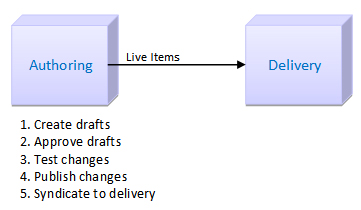Web content system overview
The type of Web content system you deploy will be determined by...
- Size of your Web content system
- Type of Web site being delivered
- Number of users creating and viewing your Web content
Web content system types
There are three main types of Web content systems:
- Single environment systems
- This is where authoring and delivery occur within a single environment.
This type of environment would be deployed by a small organization delivering a small Web site, such as an intranet. Authoring and delivering content within the same environment will be resource intensive, so the type of environment you deploy will need to be robust enough to allow authoring and delivery to occur at the same time.
For example, using clustered servers is a common solution for a single instance system.

- Dual environment systems
- This is where authoring and delivery are split into different environments. This reduces the load on both authoring and delivery and also allows you to locate your authoring environment behind a firewall. This type of system would be used when delivering externally facing Web sites, or where you have a large number of users authoring content or a large number of users viewing a Web site.

- Staged systems
- This is where a staging environment is added between the authoring and delivery environments. The staging environment can be used for user acceptance testing (UAT) or to allow to accumulate changes from your authoring environment prior to syndicating your changes to your delivery environment in a single batch. This system would be deployed when delivering large, complex sites with a large number of content creators and ensure that the Web site being delivered is accurate, error-free and can perform under load.

Environment types
- Authoring environment
- An authoring environment is used to create and manage Web content.
This is the environment used by your content creators and Web site designers. An authoring system can consist of:
- An authoring server or cluster.
- Individual UAT servers where site and content updates can be tested before being syndicated to the delivery environment.
- Staging environment
- A staging environment can consist of:
- Individual holding servers where changes from your authoring environment can be accumulated prior to syndicating your changes to your delivery environment in a single batch. Pairs of holding servers can be used to provide you with built-in redundancy.
- A complete replica of your delivery environment where UAT can occur to both review site and content updates, and to test the performance of your delivery environment.
- Delivery environment
- This environment is used by your Web site viewers. A delivery environment can consist of:
- Pre-rendered sites where a Web content site is pre-rendered as a set of HTML files which are then used to deliver a static Web site.
- A WebSphere Portal server or cluster where content is delivered using a servlet. Servlet delivery is used to deliver Web sites that contain dynamic content, but don't include any WebSphere Portal content or applications.
- A WebSphere Portal server or cluster where content is delivered using either a local or remote Web Content Viewer portlet. Web Content Viewer portlets are used to deliver Web sites that contain dynamic Web content alongside other WebSphere Portal portlets or applications.
- A combination of all of the above.